 What in the HD World?
What in the HD World? Dick De Jong
Dick De JongJanuary 21, 2010
HDTV Solutions
With over 20,000 new products being showcased by companies from around the world, the Consumers Electronics Show in Las Vegas can be a dizzying experience.
I began writing this report as soon as I and my aching feet returned from touring the massive convention center and all of the off-site hotel suites. But I held off posting my impressions.
Now, over a week later, I'm glad I did because it allowed a little distance from the din of people and public relations. I also have had a chance to sample some of the reaction to the big announcements in the TV realm and I feel that I should begin by commenting on that.
The Central Hall of the convention center was overflowing with new TVs and bigger TVs, many of them playing 3D content. In fact, this 2010 show could be labeled 3D's coming out party, with almost every major TV manufacturer presenting some manifestation of 3D technology, this year's hottest HDTV must-have.
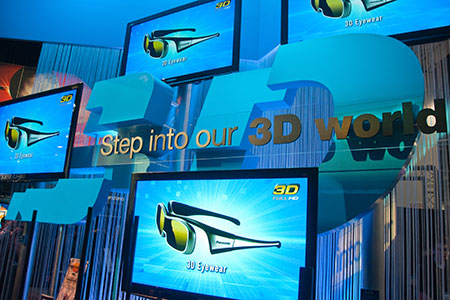
It's a 3D World
Since returning from CES, I have been reading on the web a lot of feedback from the buying public about this 3D campaign. The opinions run the gamut, but many folks are expressing frustration with this push and want to push back. Perhaps to overstate the feeling, one person said that he felt that "the TV companies were forcing 3D down our throats."
I appreciate the emotion and understand the fatigue that many are experiencing just trying to keep up with new technologies, especially in this still tight economy. But I think that if you are anxious or angry about the 3D hype, take a deep breath and exhale.
I'm not trying to be an apologist for the TV manufacturers. They are big boys that can fend for themselves. They are also companies that have had a particularly bad year and are looking for the next big thing that will generate profits. And for the moment, 3D is their ticket.
With the five-deep crowds lining up to don those glasses at the 3D booths dotting the exhibit floor, those companies were successful in creating a major buzz.

Taylor Swift
Even before the show, many were rolling out the big guns to hype 3D at their press conferences.
Sony presented Taylor Swift live on stage while projecting the country twanger in 3D to a rapt audience of scribes.
Samsung went more corporate, bringing out Jeffrey Katzenberg, head of DreamWorks Animation, and Frederic Rose, CEO of Technicolor, who gave Samsung's Tim Baxter the inaugural copy of the 3D Blu-ray of Monsters and Aliens.
Back on the exhibit floor, Panasonic highlighted its partnership with the billion dollar 3D baby, Avatar by featuring clips of the James Cameron epic on a lovely 65" VT25 plasma at its 3D booth on the showroom floor.
But amidst all the hoopla, plenty of questions were left unanswered - not the least of which was price. Though all of the companies were announcing specific models, (like Panasonic's VT25 which will be available in 50, 54, 58 and 65" sizes), prices and release dates often were not revealed.
One vague guideline was that a 3D TV will cost about $200 more than a similarly featured non-3D TV. But with all the variations of models, I would not take that number to heart.
Release dates are also nebulous, with the earliest TVs maybe blossoming this spring. I think we'll see more of them hitting the big box stores in the summer. Probably about the time that the 3D Blu-ray of Avatar is released.
Therefore, you can see that we are still in the early days, which gives us some breathing room. Let's all exhale and step back and take a look at the 3D TV ecosystem.
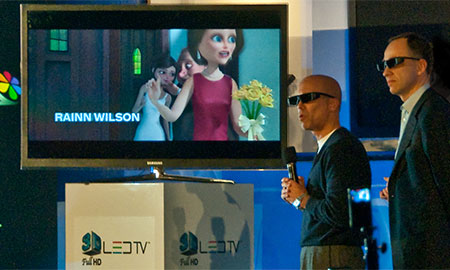
Jeffrey Katzenberg and Frederic Rose
If you are one of the millions who crowded the multiplexes this holiday season to view Avatar in 3D, then you are familiar with the visual experience of depth that manufacturers are trying to recreate with their 3D TVs.
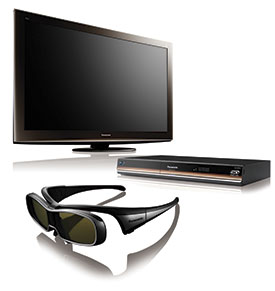
3D System
To distill the 3D TV system to its basics, you need a source that delivers 3D content to a TV that can display it and, in most setups, glasses that allow you to process the display.
Manufacturers like Mitsubishi and Samsung have produced 3D ready displays for at least a couple of years and plenty of 3D content exists. The big roadblock to 3D's acceptance in the home was a lack of a simple delivery system.
Late last year, the Blu-ray Disc Association announced the finalization of the "Blu-ray 3D" specification, which is paving the way for the release of the first Blu-ray players that can playback 3D movies like Up or Coraline. Most companies that are rolling out 3D TVs are also delivering at least one model of a Blu-ray 3D player. The proverbial chicken is about to lay the golden egg.

Sony BDP-S770 Blu-ray 3D Player
These 3D players will be able to also play non-3D DVDs, but I have not heard of any current Blu-ray players that can be upgraded to play 3D except for Sony's plans to make the PlayStation3 3D compatible with a firmware upgrade. Of course, you will still need a 3D TV. Not to sound like a broken record, but dates and prices for the new Blu-ray 3D players are yet to be announced.
More interesting to many, DirectTV revealed at CES that, "Beginning in June 2010, millions of DIRECTV HD customers will receive a free software upgrade enabling them to have access to three dedicated 3D channels through their 3D television sets." The satellite company "will offer a 24/7 3D pay per view channel focused on movies, documentaries and other programming, a 24/7 3D DIRECTV on Demand channel and a free 3D sampler demo channel featuring event programming such as sports, music and other content."
Sports, perhaps the killer app for 3D TV, will be well represented by ESPN as it "unveils the industry's first 3-D network.
"ESPN 3D will showcase a minimum of 85 live sporting events during its first year, beginning June 11 with the first 2010 FIFA World Cup match, featuring South Africa versus Mexico.
"Other events to be produced in 3-D include the 2011 BCS National Championship Game, college basketball and football contests, up to 25 World Cup matches and the Summer X Games."
Add in all of the 3D movies that have come out in the last few years and the twenty or so slated for 2010 and you can see that 3D content is already in the pipeline. Let's hope against hope that movie studios don't charge a steep premium for 3D Blu-ray titles.
Without being too technical, there definitely is more than one way of creating the binocular, three dimensional illusion on a TV screen. The most prevalent method entails displaying alternate frames (left eye and then right eye) on the TV. To complete the process, you, as the viewer, must wear active shutter glasses that block the left lens or right lens in sync with the display.
Your optic system and your brain then meld the two images together to simulate 3D. Of course, this technique does not work for a small percentage of the population and others simply find the experience uncomfortable. I sympathize with you. Just remember that all 3D TVs can revert to traditional 2D HDTVs with the touch of a button.
Another 3D system that is vying for acceptance employs polarized glasses, similar to the kind used in many movie theaters. In a suite at the Bellagio, LG Display demonstrated both 3D display systems, those with shutter glasses and those with polarizing. Each was effective, but I tended to prefer the polarized method.

JVC GD-463D10 Monitor
JVC exhibited their GD-463D10, a 46-inch LCD monitor that features a polarizing technology called Xpol "for flicker-free stereoscopic images with inexpensive (passive) glasses." The TV is actually shipping now, but at $8000 it is really not a consumer product.
Of course, once again, I seem to be swimming against the current because most of the 3D TVs being introduced are employing the active shutter glasses.
Reading reactions to this 3D phenomenon, the biggest bugaboo revolves around the glasses that you need to wear. (3D technologies that don't require glasses are popping up, but from what I have seen, they are not quite ready for prime time viewing.)
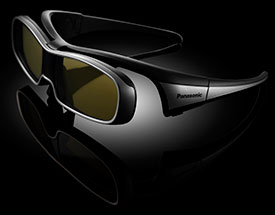
The designs of both the polarized and active shutter glasses have evolved a long way from the funky cardboard red and green lensed glasses of yesteryear. But wearing them for an extended period can be annoying, especially if you already wear glasses to see.
The active shutter glasses also require batteries to power the constant shuttering. Even if the batteries are rechargeable, you can imagine what your response will be if they poop out on you in the middle of the big game.
In your frustration, just don't slam them on the ground because a pair of shutter glasses can cost around 100 bucks, though I can only imagine that the price will drop when the market expands. Polarized glasses are much less expensive, which is why movie theaters hand them out when you buy your ticket.
From what I am hearing, most TV manufacturers are not packaging more than one set of active shutter glasses with their 3D TVs. The cost of extra pairs will be borne by you. If you have a big family, that can add up pretty quickly.
If you are already planning a BCS Championship 3D party for next year, you might consider making it BYOG (bring your own glasses). And oops, good luck not sitting on the glasses that you left buried on the couch.
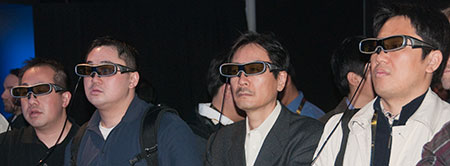
BYOG
As I was walking down the corridors of CES, I heard a number of people exclaim that 3D TVs will never catch on until they get rid of the glasses. I'm not so sure. People around the world have plopped down over a billion dollars just for the privilege of wearing those glasses to watch blue Na'vi soar on their Ikran over the verdant Pandora.
With that said, in the spirit of full disclosure, let me admit that personally, I'm not a big fan of 3D. I saw Up at a movie theater in 3D and after a while, I took off the glasses because they dulled the colors. I actually didn't like the movie.
Since then, I have watched the Blu-ray (non-3D version) of Up and I'm amazed at its vibrant color palette and overall visual storytelling. I discovered a new found appreciation for the film. I actually use certain clips as references when I review TVs.
Running from booth tour to booth tour, I didn't have enough time to closely study and compare the different 3D TVs. And considering the crowds and the jostling necessary just to spend a few minutes in front of a 3D clip emanating from who knows what source, CES is not a great venue to make any evaluation of one display over another.
But I did witness a few TVs that caught my fancy.
First, Toshiba was showing their CELL TV. If you look back at my 2009 CES report, you will see an image of a 4K x 2K (four times the resolution of HD's 1920 x 1080) CELL TV prototype.
This year, Toshiba is officially rolling out their ZX900 Series CELL TV into the U.S. market. This HDTV includes a separate box that contains the CELL Engine, which Toshiba claims "has 143 times the processing power available in current TV models."
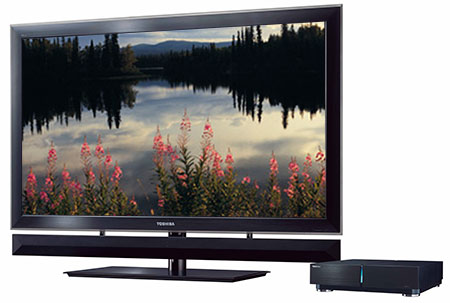
Beyond displaying native 3D content, the Engine can take any 2D content and convert it into 3D in real time. The examples that I saw were impressive but did not match the wow factor of true 3D content. Then again, I didn't expect it to pack the same wallop.
The box also includes a 1TB HDD, a Blu-ray player, and 802.11n Wi-Fi connectivity, which allows access to Toshiba's Internet content partners like Netflix, VUDU, CinemaNow, and Pandora.
Finally, this one stop shopping display also includes a Video Phone capability. You can video conference over IP with friends and family (with compatible devices) from the comfort of your living room. The Toshiba CELL XV900 Series will be available in 55" and 65" sizes.
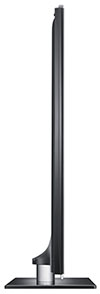
Samsung's PDP8000
3D TV
Other manufacturers were showcasing 3D TVs that contained some of these features, but I didn't see one that included the whole package. As for price...?
Samsung has jumped into the 3D arena feet first. Their three top-of- the-line LED TV series, the 7000, 8000 and 9000, all include Samsung's proprietary built-in 3D processor, which also can auto-convert 2D content into 3D in real time.
Their flagship 9000 series is thin as a rail - a very razor thin rail. Samsung's 8000 series of plasmas also cast a slim shadow, measuring less than an inch thick. The 7000 and 8000 plasmas also furnish the built-in 3D processor. As a companion product, Samsung announced the BD-C6900, their first 3D Blu-ray player.
Finally, I really liked Panasonic's VIERA Plasma 3D TVs, partially because they were displaying Avatar clips. Beyond that, the 3D picture on the TC-P65VT25 looked rich and natural.
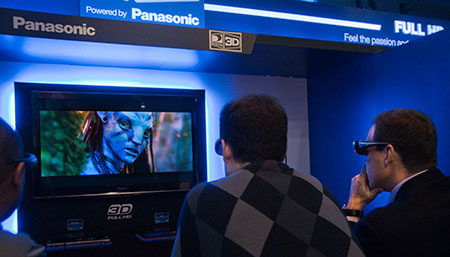
Avatar Clip Playing at the Panasonic Booth
I prefer plasmas and this THX certified HDTV looks like a winner. Of course, I can't pass judgment on it - or any of the other TVs that I saw at CES - until I get them into our facility.
Now, if 65" seems just a little too small for your 3D appetite, then Panasonic was showing off a 152" plasma eye popper that was Full HD 3D capable. And as icing on the cake, its resolution is 4K x 2K or 4,096 pixels wide by 2,160 high.
For those low budget indie Cameron hopefuls, Panasonic unveiled engineering samples of "the world's first professional, fully-integrated Full HD 3D camcorder" which will be released in the Fall of this year. Panasonic will begin taking orders in April.
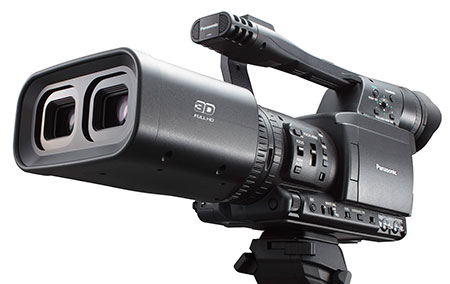
As a final thought to those of you who feel left behind in this 3D parade either for financial or physical reasons, I wouldn't fret too much. The big wheel of TV technology will keep on turning. Picture quality will continue to improve, prices will fall and if you are so inclined, you can catch the next must-have when it comes rolling along in the not too distant future.
Stay tuned.
Posted Jul 25, 2010 9:38:20 AM
By Wayne Ulery